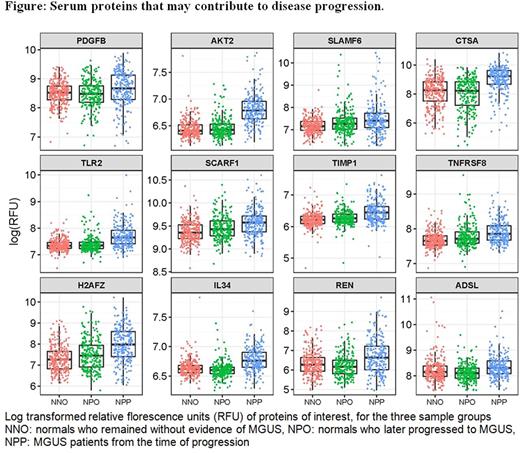Abstract
Introduction: Monoclonal gammopathy of undetermined significance (MGUS), is a pre-malignant plasma cell disorder that affects roughly 4% of the population older than 55 and is associated with a 1% per year risk of progression to multiple myeloma (MM). Successfully intercepting disease progression from MGUS to MM requires a deeper understanding of MGUS biology, identification of prognostic biomarkers and potential targets for interception. With these aims, a cohort of samples were profiled from the Olmstead County Study, which followed >20,000 subjects for over 20 years as they aged and developed a variety of diseases, including MGUS and MM (Kyle, et al. Oncology 2011). Samples were utilized from 2 cohorts: 1) healthy normal individuals with no subsequent diagnosis of plasma cell disorder, and 2) healthy normal individuals who go on to develop MGUS, with a second sample at the time of MGUS diagnosis. Broad proteomic profiling was performed on these samples, to identify pathways involved in the early stages of MGUS disease biology.
Methods: Proteomic profiling was performed on 727 serum samples using the SOMAscan Assay 1.3k (SomaLogic, Inc., Boulder, CO): 267 from normals who remained without evidence of MGUS, 235 from normals who later progressed to MGUS, and 225 from these MGUS patients from the time of progression. Various univariate, multivariate, and co-expression statistical testing methods were applied on age matched sample sets for data exploration and for potential predictive marker/signature identification.
Results: A set of serum markers were identified that were differential between age-matched normal and MGUS patients, including albumin, PDGFB, AKT2, SLAMF6, TRL2, and Cathepsin A. Subtle differences in protein levels were observed in serum of normal individuals who remained plasma cell disorder free versus those who later progressed to MGUS including SCARF1, TIMP1, TNFRSF8, H2AFZ, renin, IL34, ADSL, SLAMF6 (Figure), which may help develop a potential serum diagnostic for assessing risk of MGUS.
Conclusions: Proteomic profiling allowed detection of markers that are potentially indicative of early event pathogenesis and disease progression in MGUS patient serum samples. These findings may contribute to biological understanding of pre-malignant disease. Interestingly, some of the proteins identified, such as SLAMF6, are currently being evaluated as therapeutic targets in MM, adding validity that these pathways are early contributors to disease progression and may be important for interception and prevention.
Casneuf: Janssen: Employment. Tryputsen: Janssen: Employment. Adams: Janssen: Employment. Lysaght: Janssen: Research Funding. Sasser: Janssen: Employment. Kumar: Skyline: Honoraria; Celgene, Millennium/Takeda, Onyx, AbbVie, Janssen, Sanofi, Novartis, Amgen, Genentech, Merck, Oncopeptides, Roche, Skyline Diagnostics: Research Funding; Celgene, Millennium, BMS, Onyx, Janssen, Noxxon, AbbVie, Amgen, Merck, Oncopeptides, Skyline Diagnostics, Takeda: Consultancy.
Author notes
Asterisk with author names denotes non-ASH members.


This feature is available to Subscribers Only
Sign In or Create an Account Close Modal